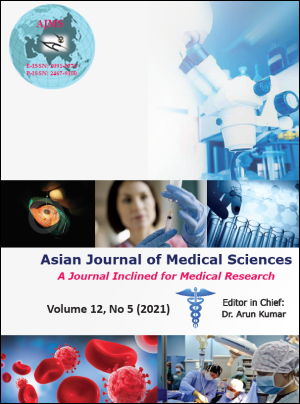Clinico- bacteriological profile of Community Acquired Pneumonia (CAP) in children aged 3-59 months: A cross sectional study
Keywords:
Blood culture, Community acquired pneumonia, Nasopharyngeal swab, S aureusAbstract
Background: Worldwide community-acquired pneumonia (CAP) is the major cause of high mortality among under five children in India. After introduction of Pneumococcal and H. influenzae vaccination there is paucity of data regarding etiological profile of pneumonia.
Aims and Objective: To evaluate the Clinico- epidemiological profile and etiology of community acquired pneumonia in children.
Materials and Methods: We enrolled children aged 3-59 months with CAP (based on WHO criteria of tachypnea with cough or breathing difficulty) over 18 months and recorded presenting symptoms, clinical signs and chest radiography. We performed blood and nasopharyngeal swab (NPS) bacterial culture simultaneously to detect etiological agent of community acquired pneumonia in children.
Results: Out of 150 cases of CAP, 90 % of caeses had cough and fever and nearly 80-90% cases had tachypnea and crackles on examination. Radiological findings suggestive of pneumonia was seen in 86% cases . Most common organism isolated was S aureus in both NPS culture (18.7 %) and blood culture (14.7 %). Other common organisms detected in NPS culture were S pneumoniae (6%), E Coli (4.7%), Klebsiella (4.7%), CONS (3.3%), and Pseudomonas (2.7%). In blood culture the common organism detected after S aureus was E coli (5.3%), S pneumoniae (3.3%), Klebsiella (3.3%), CONS( 3.8%), and Pseudomonas (2.5%).
Conclusions: We observed that S aureus was the predominant etiological organism isolated in both blood and nasopharyngeal swab bacterial culture in patients suffering from community-acquired pneumonia.
Downloads
Downloads
Published
How to Cite
Issue
Section
License
Authors who publish with this journal agree to the following terms:
- The journal holds copyright and publishes the work under a Creative Commons CC-BY-NC license that permits use, distribution and reprduction in any medium, provided the original work is properly cited and is not used for commercial purposes. The journal should be recognised as the original publisher of this work.
- Authors are able to enter into separate, additional contractual arrangements for the non-exclusive distribution of the journal's published version of the work (e.g., post it to an institutional repository or publish it in a book), with an acknowledgement of its initial publication in this journal.
- Authors are permitted and encouraged to post their work online (e.g., in institutional repositories or on their website) prior to and during the submission process, as it can lead to productive exchanges, as well as earlier and greater citation of published work (See The Effect of Open Access).




